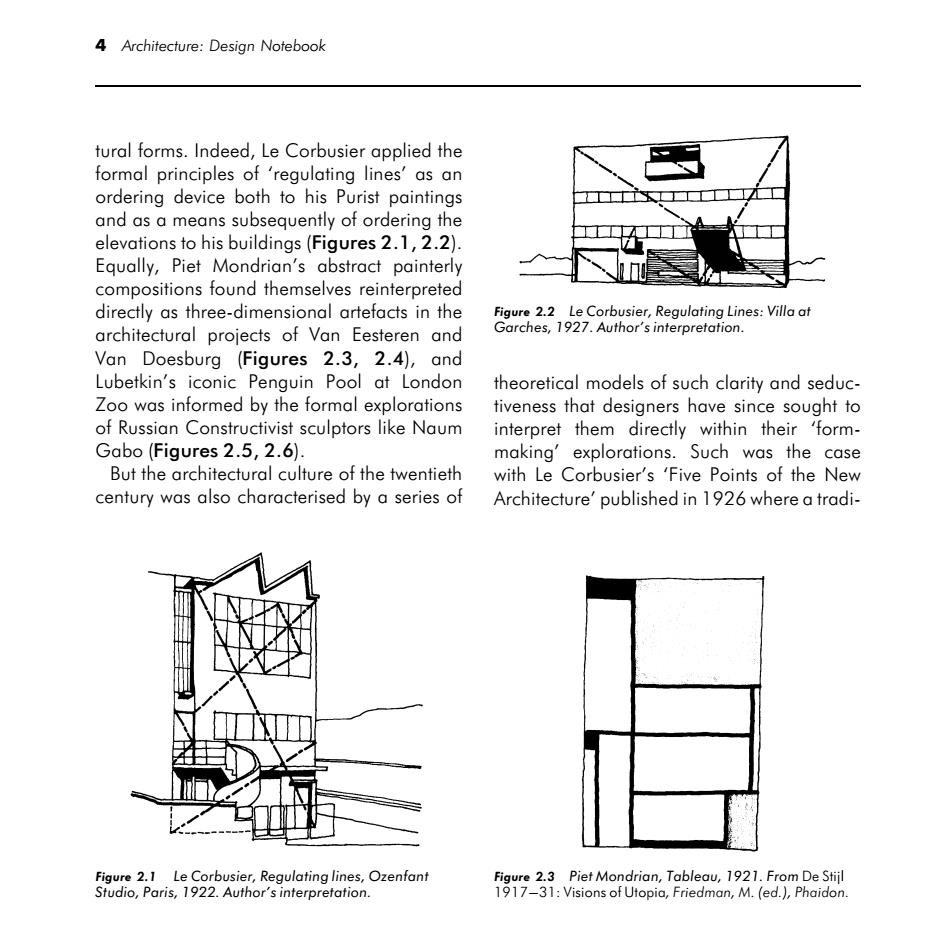正在加载图片...

4 Architecture:Design Notebook tural forms.Indeed,Le Corbusier applied the formal principles of regulating lines'as an ordering device both to his Purist paintings and as a means subsequently of ordering the elevations to his buildings(Figures 2.1,2.2). Equally,Piet Mondrian's abstract painterly compositions found themselves reinterpreted directly as three-dimensional artefacts in the Figure 2.2 Le Corbusier,Regulating Lines:Villa at architectural projects of Van Eesteren and Garches,1927.Author's interpretation. Van Doesburg (Figures 2.3,2.4),and Lubetkin's iconic Penguin Pool at London theoretical models of such clarity and seduc- Zoo was informed by the formal explorations tiveness that designers have since sought to of Russian Constructivist sculptors like Naum interpret them directly within their 'form- Gabo (Figures 2.5,2.6). making'explorations.Such was the case But the architectural culture of the twentieth with Le Corbusier's 'Five Points of the New century was also characterised by a series of Architecture'published in 1926 where a tradi- Figure 2.1 Le Corbusier,Regulating lines,Ozenfant Figure 2.3 Piet Mondrian,Tableau,1921.From De Stijl Studio,Paris,1922.Author's interpretation. 1917-31:Visions of Utopia,Friedman,M.(ed.)Phaidon.tural forms. Indeed, Le Corbusier applied the formal principles of ‘regulating lines’ as an ordering device both to his Purist paintings and as a means subsequently of ordering the elevations to his buildings (Figures 2.1, 2.2). Equally, Piet Mondrian’s abstract painterly compositions found themselves reinterpreted directly as three-dimensional artefacts in the architectural projects of Van Eesteren and Van Doesburg (Figures 2.3, 2.4), and Lubetkin’s iconic Penguin Pool at London Zoo was informed by the formal explorations of Russian Constructivist sculptors like Naum Gabo (Figures 2.5, 2.6). But the architectural culture of the twentieth century was also characterised by a series of theoretical models of such clarity and seductiveness that designers have since sought to interpret them directly within their ‘formmaking’ explorations. Such was the case with Le Corbusier’s ‘Five Points of the New Architecture’ published in 1926 where a tradi- 4 Architecture: Design Notebook Figure 2.1 Le Corbusier, Regulating lines, Ozenfant Studio, Paris, 1922. Author’s interpretation. Figure 2.2 Le Corbusier, Regulating Lines: Villa at Garches, 1927. Author’s interpretation. Figure 2.3 Piet Mondrian, Tableau, 1921. From De Stijl 191731: Visions of Utopia, Friedman, M. (ed.), Phaidon